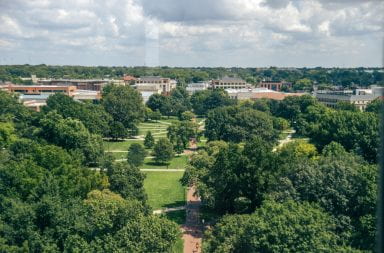There is a greenhouse for plants without a greencard. That greenhouse sits above parking garage K on 12th Avenue.
As greenhouse coordinator, Joan Leonard is responsible for plants that are illegally brought into the United States that have been confiscated by the government.
The U.S. Fish and Wildlife Service has designated this greenhouse as a plant-rescue center. In other words, plants are sent to the greenhouse that have been seized by border agents. The program has been in existence since 1978.
The confiscated plants come from all parts of the world and are not able to enter the United States because of international trade laws.
Leonard has been taking care of these types of plants for 18 years. She said shipments of plants come from all across the country, in all different shapes and sizes and it is her responsible to keep the confiscated plants alive.
“We get plants that are in good shape and then we get plants that are not in good shape,” Leonard said. “It is our job to bring these plants back to life and to care for them.”
The plants are sent to Leonard wrapped up in newspapers and boxed in small packages. She said that they usually receive shipments of about 50 plants about three or four times a year.
Most of the plants are usually in seed form and are unidentifiable until they bloom. The identification process can take a while, sometimes many months, Leonard said. Some of the plants are dead as soon as the box is open.
“Plants need both light and water to survive,” Leonard said. “Most of the time plants are in people’s luggage. People usually don’t water their luggage.”
After the plants are brought back to life they are used for educational purposes and viewed by students.
Border agents have a list of centers to call that can take the illegal plants, Leonard said. There are 73 greenhouses in the country that will take the plants; one greenhouse does not have preference over another, she said.
“Most of the plants we receive are orchids but we take everything including cacti, cycads and many others,” Leonard said. “Some places are very picky about what they take but we take everything.”
Carol Allen, supervisor of the horticulture at the U.S. Botanic Garden, said space is an issue when receiving shipments of plants. The U.S. Botanic Garden can only take orchids and cacti for lack of space, she said.
Most plants do not survive the quarantine they get when they cross the border, Allen said.
“Orchids and cacti are extremely immune to the quarantine they are given at the border and that is a reason we only take those types of plants,” Allen said.
The greenhouse at Ohio State receives plants as soon as they are confiscated from borders all over the country. The U.S. Fish and Wildlife Service ships the plants as soon as possible, Leonard said.
“Most of the time it’s tourists who don’t know any better and try to dig up a plant and bring it back but they do not know that it’s illegal,” she said, “A majority of the cacti we have come from Mexico.”
Recently, funds have not been available to care for large shipments, as result, Leonard has not received a shipment since August 2004.
OSU is not the only greenhouse in Ohio to be a part of the program to help rescue plants. The Franklin Park Conservatory, the Krohn Conservatory in Cincinnati, the Cleveland Metroparks Zoo and the Holden Arboretum in Kirtland are all members of the plant-rescue program.


